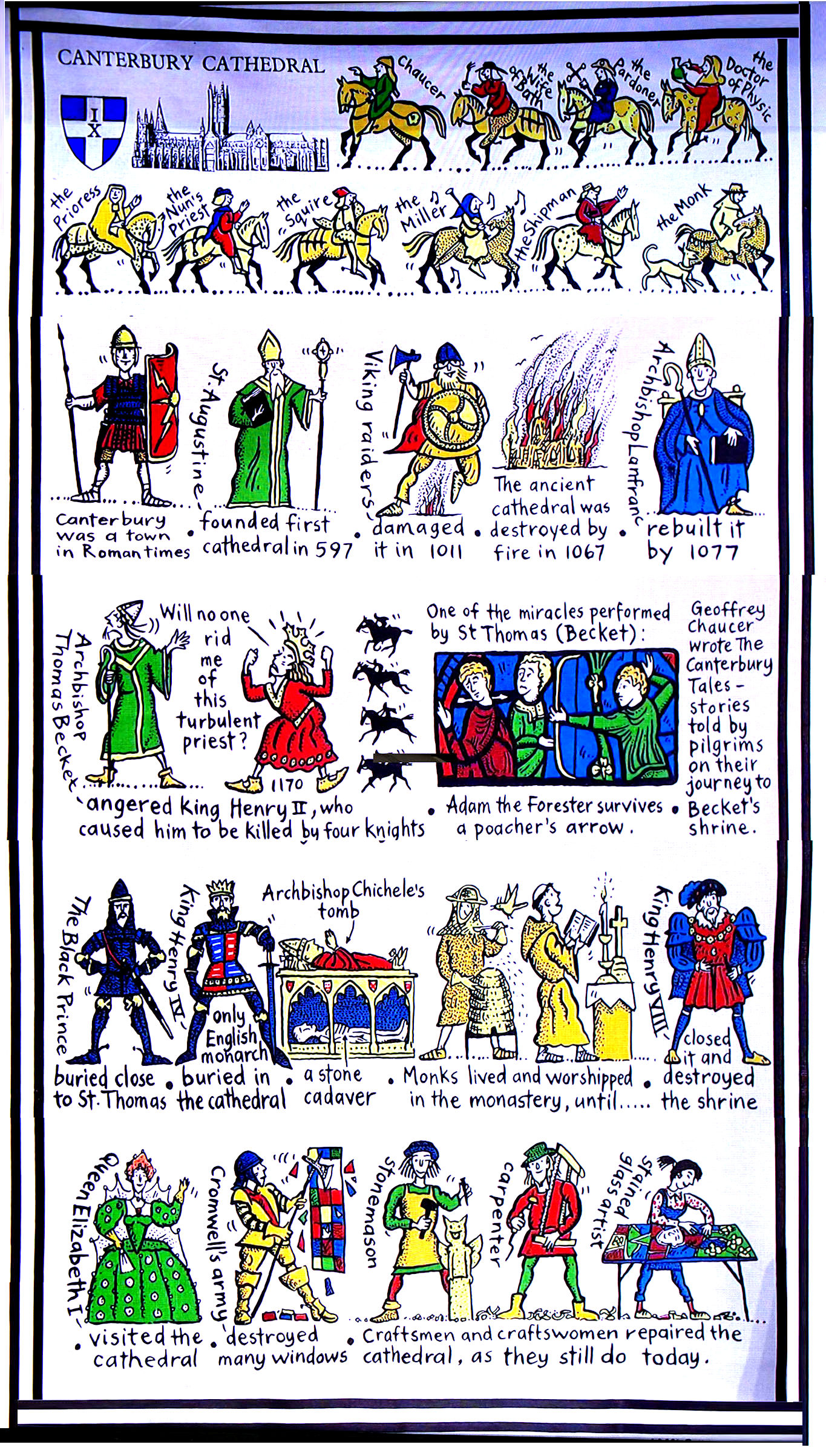Canterbury Tales - General Prologue
Introduction
In the history class in junior high school, I was
taught that Canterbury Tales by Geoffrey Chaucer is a representative piece of
literature from medieval England but nothing more.
As written in the
General Prologue, The Canterbury Tales is a story in which twenty-eight
men and women who gathered in the Tabard Inn at the Southwark in London to
pilgrim to Canterbury had agreed with a proposal of the inn’s master to
present stories on their own one by one in order to relieve the boredom of
the journey of fifty miles that would have taken one week or more on horse
back or horse cart. The whole text was written in the form of a poem in the
Middle English, not in Latin that was the major writing language at that
time, with Lambic pentameters and Rhyming couplets.
The original copy that Chaucer had written
is unknown and various copies are known. In this article, the text in
https://thecanterburytales.co.uk/the-prologue/, based on the Cambridge
Version, has been adopted herewith.
The Canterbury Tales has been translated
into many foreign languages. In Japan, many translations have been published
but the styles were various. The translation by Kaneko[1]
that is assumed to be the earliest case was flat prose that followed the
story, so that the artistic quality of the original work was inevitably lost.
Karibe and Tanaka
[2] concluded that a literal translation
was impossible and translated the poem paragraph by paragraph in a free
verse style.
Masui [3]
respected each line and tried
to translated it by retaining the poetic atmosphere
but the order of lines were changed in many places.
Watari [4]
translated every line in the traditional Japanese seven‐five‐syllable
meter, instead of the Lambic pentameters and Rhyming couplets for English.
The rich vocabulary used in his translation is astonishing, reminding one of
the high-level culture of scholars who were educated in the middle and high
schools in the old education system before the War.
The translations of the first paragraph
(28lines) are compared in Table 1.
Table 1 Comparison of Japanese Translation of Canterbury Tales – General Prologue (The first 18 lies)
|
|
T. Watari(亘俊雄)[4] |
M.Masui(桝井迪夫)[3] |
T. Karibe, Y. Tanaka(苅部,田中)[2] |
K.Kaneko(金子健二)[1] |
|
0 |
(此処にカンタベリー物語の本が始る) |
カンタベリー物語の書ここに始まる。 |
|
甘露のような四月の雨がひとふりすると,かわききっていた三月の大地が底までうるおい,木木は生気をとりもどし,つぼみ もほころびかけてきた。森の梢や灌木の茂みは西風のかぐわしい呼吸(いき)にふかれて,やわらかい小枝をのばす。 まだ若い太陽は白 羊宮(星座の名。四月になると,太陽は白羊宮と金牛宮のあいだにはいる)に半分はいったところである。一晩じゅう目をあけ て眠っていた小鳥は,節もおもしろくさえずっている。......すべてがこのように活気にあふれるのは,みんな自然の力のおかげ である。 この季節になると,遠い地方の有名な霊剤にもうでたり,外国の岸をふんでみたいと思うものだ。とくにイギリスの諸州から カンタベリー寺院をおとずれ,殉教者の霊廟を拝もうとするものの数は多い。
|
|
1 |
四月の優しい雨が |
四月がそのやさしきにわか雨を |
四月がその恵みの雨を |
|
|
2 |
三月の,乾いた根までしみ透り, |
三月のひでりの根にまで滲みとおらせ, |
三月の乾き切った根元まで染み込ませ, |
|
|
3 |
木木は皆,心までしっとり濡れそぼった。 |
樹液の管ひとつひとつをしっとりと |
あらゆる導管を活液で潤し, |
|
|
4 |
お蔭で花が萌えたとき, |
ひたし潤し花も綻びはじめるころ, |
その活力から花が咲き出します頃, |
|
|
5 |
また西風の香ぐほしい,その息ぶきも |
西風もまたその香しきそよ風にて |
また西風のゼフィルスがその香しい息吹を |
|
|
6 |
目ざませて,林やヒースの |
雑木林や木立の柔らかき新芽に息吹をそそぎ, |
いたるところの森や原で |
|
|
7 |
若枝を。又うら若い太陽は, |
若き太陽が白羊宮の中へその行路の半ばを急ぎ行き, |
若芽に吹きかけ, 若い太陽が |
|
|
8 |
白羊宮を半ば馳け, |
小鳥たちは美わしき調べをかなで |
白羊宮の道程の半ばを通過し, |
|
|
9 |
小鳥は樂しく囀づつて, |
夜を通して眼をあけたるままに眠るころ, |
小鳥達がメロディをさえずり, |
|
|
10 |
よるも夜通し,目をあけたまま眠る時 |
―かくも自然は小鳥たちの心をゆさぶる |
一晩中目を開けて眠る頃になりますと, |
|
|
11 |
(こんなにも天然は,彼らの胸をそそるのだ。 |
ちょうどそのころ,人々は巡礼に出かけんと願い, |
それほど自然は彼らの心をかきたてるのですが, |
|
|
12 |
この時人人は,巡禮の旅を思ひたち, |
棕櫚の葉もてる巡礼者は異境を求めて行かんと冀う, |
人々は巡礼の旅に出かけたくなるのです. |
|
|
13 |
また旅僧は,異國の岸べにあこがれて, |
もろもろの国に知られたる |
巡礼者達は異国の岸辺を訪れ, |
|
|
14 |
國々に,遠く聞えた寺々や, |
遥か遠くのお参りどころを求めて。 |
諸国に知れ渡った聖廟へと赴きたくなり, |
|
|
15 |
殊にもさらにイギリスは, |
とりわけ英国各州の津々浦々から |
特にイングランドの津々浦々からは |
|
|
16 |
津々浦々のはしからも, カンタベリーへやつてきて, |
人々はカンタベリーの大聖堂へ,昔病めるとき, |
人々がカンタベリィに向かい |
|
|
17 |
有難い,殉教者様に.詣でては |
癒し給いし聖なる尊き殉教者に |
病気のとき癒して下さった, あの聖なる, |
|
|
18 |
病氣全快の,お禮参りをするのであつた。 |
お参りしようと旅に出る。 |
有難い殉教者に詣でたくなるのです. |
1. Kenji Kaneko (trans) Canterbury Tales, Toado 1917 / 金子健二 (訳),カンタベリー物語, 東亜堂書房, 1917
2.Tsuneharu Karibe, Hisaaki Sasaagawa, Yoshiharu Tanaka, A New Invitation to Chaucer's General Prologue to Canterbury Tales, Shohakusha 2000
3. Michio Masui, Complete Translation: CanterburyTales 1/3, Iwanami1995 /桝井迪夫。完訳 カンタベリー物語 上, 岩波書店 1995
4. Toshio Watari (Transl.), The Canterbury Tales: Prologue, Shoubundo Publ., Tokyo, 1934.7.20./亘理俊雄(譯)「カンタベリー物語・序歌」,尚文堂,東京,1934.7.20.
